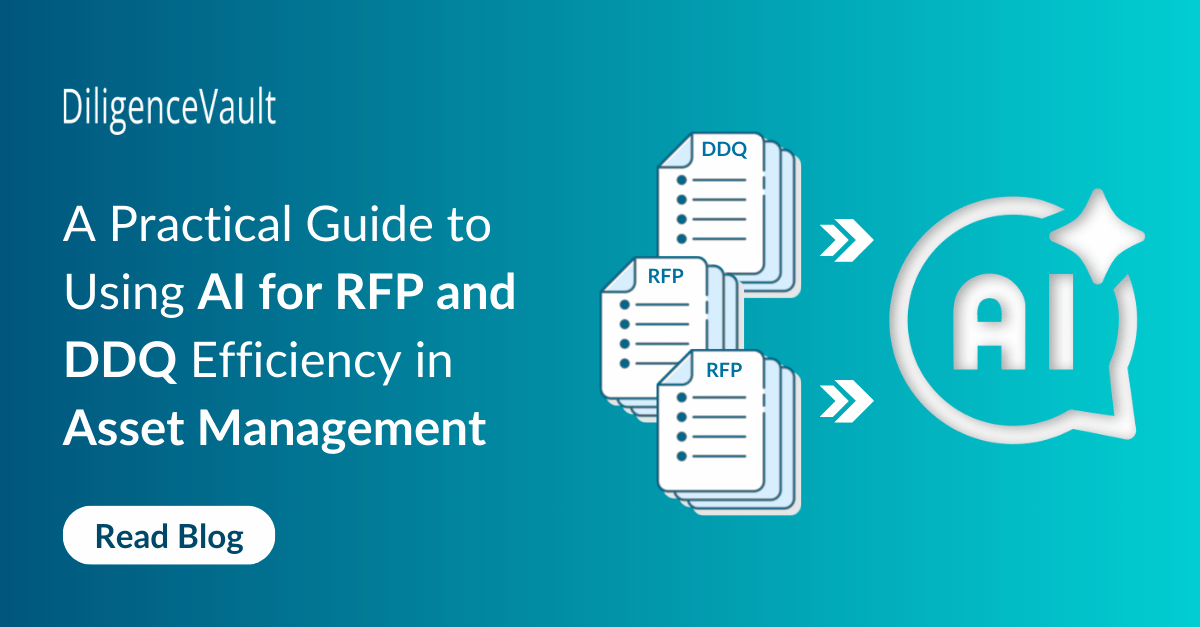Answering DDQs and RFPs remains one of the most resource-intensive tasks for asset managers. Teams often struggle with outdated or inconsistent content, duplicated efforts, and increasing compliance demands. Each new request brings pressure to respond quickly while maintaining accuracy, consistency, and alignment with firm messaging.
These challenges are especially acute for emerging managers, who may lack centralized content libraries or dedicated RFP teams. Inconsistent responses, stale language, and manual workflows can not only slow down submissions but also raise red flags for investors.
This blog outlines how asset managers can use Generative AI more effectively by focusing on common friction points in the RFP/DDQ process. These include improving input quality, automating the first draft of a DDQ or RFP response, maintaining authenticity, and reducing the compliance burden.
1. Ensure High-Quality Input
To get the best out of AI, the quality of input content is essential. Poor input results in poor output.
- Stale Content = Stale Output. If the input content is outdated, the generated responses will lack relevance and accuracy.
- Conflicting Inputs = Confused Output. If the input has inconsistencies or contradictions, the AI will likely produce confusing or contradictory responses.
- Missing Context = Generic Responses. Without sufficient context, the AI will generate generic or irrelevant answers that don’t fully address the question.
Action Tip: Build a library of standard content, including fund documents, policies, and vendor agreements, to ensure AI-generated content remains relevant and accurate over time. This is especially useful for emerging managers who can use AI to draft content from these foundational materials.
2. Maintain Consistency in Responses
Standardization is critical in ensuring that your RFP/DDQ responses align with company policy and messaging, while also easing compliance processes.
- Avoid Re-Generating Responses with AI. Continuously regenerating responses leads to variations that can introduce inconsistencies, making your submissions less consistent across various investors.
- Consistency in Compliance and Messaging. Consistent and compliant answers ensure that your responses maintain a uniform tone and message, which is essential in our industry.
- Compliance Burden. If AI generates new answers every time, it likely creates unnecessary workload for compliance teams who must review and verify each response.
Action Tip: Use pre-approved content to auto-populate DDQs and RFPs to ensure consistency across responses and reduce the workload on compliance teams.
3. Smart Use of AI Capabilities
Maximizing AI efficiency means leveraging its features intelligently to improve the quality and clarity of your responses while tailoring them to specific needs.
- Manage Word Limits. AI can help ensure that pre-approved content is adjusted to meet specific word count requirements, saving RFP writers and investor relations teams significant bandwidth.
- Adjust Tone and Voice. Customize the voice of responses to fit the audience, whether it’s more formal for institutional investors or more approachable for retail investors.
- Improve Writing Quality. Use AI to enhance grammar, clarity, and overall readability, improving the quality of your submissions.
- Summarize Policies and Documents. AI can help distill large documents into concise summaries, helping to create new content from existing material without starting from scratch.
- Bulk Update Your Pre-Approved Content. AI can help replace content in bulk for any significant key person, regulatory, or fund structure changes. This is a much more powerful application than simple find and replace.
- Autofill with Confidence. Deploy AI to autofill DDQs and RFPs. Whether it’s responding to various formats of staff turnover questions, summarizing portfolio exposures from your commentaries, or converting paragraph responses into confirmatory Yes or No answers.
Action Tip: Use AI for practical enhancements like adjusting tone and length, summarizing content, and auto-filling repetitive responses to improve output quality and save time.
4. Maintain Authenticity
In an era of AI-assisted content, it’s important to differentiate your responses from others by staying authentic.
- Be True to Your Voice. AI can help generate responses but always ensure that the responses align with your company’s values, tone, and voice. Authenticity builds trust and credibility with investors.
- Avoid Over-Reliance on AI. While AI is a great tool, it shouldn’t replace the unique insights and perspectives that your RFP and investor relations team brings to the table.
Action Tip: Make sure to incorporate your unique expertise and perspective into AI-generated responses, ensuring that they reflect your firm’s identity and values.
5. Track Responses
Tracking and organizing AI-generated responses is essential for compliance, future use, and continuous improvement.
- Maintain an Audit Trail. Keep records of all DDQ and RFP responses generated by AI, including the inputs, outputs, and revisions made. This is crucial for transparency and compliance.
- Review and Refine Over Time. Regularly review AI responses and track changes to improve the quality of the output over time. This ensures that responses stay current and aligned with evolving investment strategies and policies.
Action Tip: Create a centralized system to manage, track, and store all AI-generated responses for easy access, review, and future reference.
6. Avoid Common Pitfalls That Lower AI Efficiency
While AI can enhance RFP and DDQ workflows, certain practices can hinder its effectiveness.
- Overloading AI with Documents. Providing AI with too much irrelevant or overly complex material can increase the risk of inaccuracy. Precision and context are critical for higher-quality outputs.
- Uncontrolled Generation of Responses. Letting AI generate responses without context, guidance, or review can lead to incoherent or suboptimal outputs.
- Lack of Review. AI-generated responses need human oversight. Failing to review them can lead to errors or missed opportunities for improvement, and a risk of misrepresentation to investors.
- Excessive Adjectives and Superlatives. Responses that are heavy on fluff or exaggerated language without clear context can be off-putting to investors, who prefer clarity and substance.
Action Tip: Be mindful of the input given to AI, ensure responses are reviewed, and avoid unnecessary embellishments that detract from the content’s value.
Final Thoughts: Maximizing RFP/DDQ Efficiency with Gen AI
RFP and investor relations teams of the future will be super users of AI. But achieving meaningful and scalable impact requires more than just adopting new AI tools. It requires a strong process foundation of maintaining a centralized content library, ensuring team training of smart use of AI, establishing audit trails, and enabling review workflows.
With these frameworks in place, AI becomes not just a productivity booster but a strategic enabler. Firms that invest in data quality, structure and governance today will be best positioned to scale AI effectively and confidently tomorrow.
Looking to Explore Further? Check Out These Resources
-
- Join us for our upcoming webinar to learn how Generative AI is reshaping document management, enabling teams to drive efficiency and scale.
Register Here. AI-Powered Document Intelligence for Due Diligence and RFP/DDQ Teams - See how AI is transforming due diligence for asset managers by simplifying workflows, improving accuracy, and reducing manual effort.
Access the Full Case Study Here. RFP/DDQ Use Cases with DV Assist - The asset management industry faces inefficiencies due to lack of standardization. Explore the billion-dollar problem in this blog.
Read the Full Blog Here. Standardization – The Billion Dollar Problem in Asset Management
- Join us for our upcoming webinar to learn how Generative AI is reshaping document management, enabling teams to drive efficiency and scale.



